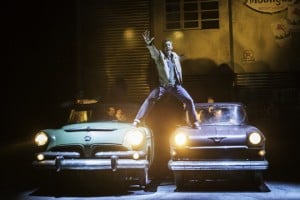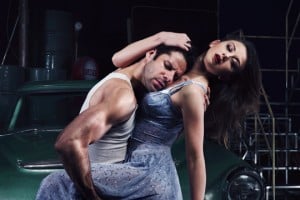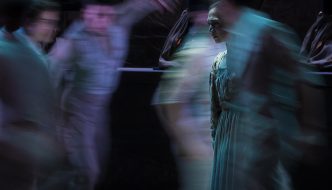Review: The Car Man – ‘A feast for all the senses’
July 8, 2015
[All images courtesy of sadlerswells.com]
Matthew Bourne’s The Car Man promised from the outset to be almost all of my favourite things: a ballet, based (very loosely) on an opera, with a heavy dose of sex and nudity. If only I could have had my dinner while watching it, I think my night would have been complete. Lack of food aside, the New Adventures team have once again produced a peerless spectacle, and a superb tribute to Bizet and his classic work, Carmen. Although the reworking of the plot is closer to that of The Postman Only Rings Twice than the opera, it carries the spirit of seduction and bohemian living that Carmen is all about.

Making its debut in 2000 (then revived in 2007), The Car Man takes us back to 1960s Harmony, a small American town that runs on sweat, car oil and lust. Centred around the local garage and diner, we are introduced to a world where machismo is the order of the day, and men are measured by the size of their biceps and of their… perhaps we’ll leave it at biceps. It’s no paradise, but the residents are happy enough to drink and screw their way through life, and all seems right with the world. Not so for everyone, however. Lana is fed up with her domineering husband Dino, the garage’s owner, and takes every opportunity to flirt in order to find some escape. At the other end of the scale, Angelo, who doesn’t fit in with the masculine ideal, is treated as the local loser. He is blind to the innocent affections of Rita who, unlike her sister Lana, is not interested in the debauchery all around her.
Their worlds are turned upside down with the arrival of Luca, who drifts in looking for work and quickly finds his place at the top of the hierarchy. He flirts his way through the town, before settling on both Lana and Angelo; first he seduces Angelo in one of the cars, then Lana in her marital bed. Soon after, at a wedding, Dino begins to suspect that Luca has been involved in something untoward. He follows him and Lana as they head to the garage for some extramarital activities, and catches them in the act. In the ensuing struggle, Dino is killed by a blow to the head, though remains conscious long enough to claw his way to Angelo (who is still out in the street, reeling from his encounter with Luca) for help, leaving him, covered in blood, beside the body. The police arrive, and Lana capitalises on the situation, putting Angelo firmly in the frame.

Act two opens in a high-end cabaret, where Luca is splashing off his new found cash on copious amounts of champagne, but his outward joie de vivre is punctured by his underlying guilt. Meanwhile, Rita visits Angelo in prison, still prepared to support him. After she leaves, Angelo is lead away by a guard, who attempts to rape him. Knocking him unconscious, Angelo steals his uniform and revolver, and escapes.
Back at the cabaret, Luca’s drunken stupor descends into hallucinations, with a blood-drenched Dino making a Banquo-esque appearance amongst the dancing patrons. Luca staggers back to the garage, which is now boarded up and for sale. Clearly the loss of the garage has been a blow to the community, as unemployment has led to alcoholism and violence amongst the men and women alike. As the town prepares for a fight night, Angelo makes a reappearance and Rita runs to him. He is no longer the man she knew, groping and pawing at her, and eventually taking her hostage with the revolver at her back. From this point, the situation goes from bad to worse as Angelo and Luca come to blows; without giving away too much of the ending, it is clear from this point onwards that not everyone will live to see the curtain fall…

This dark, gritty narrative shows off everything that Matthew Bourne does best. While classical ballet is an exercise in creating dreams and fantasies, Bourne and his dancers are at their finest when dealing with the complexities of emotions and the darker side of human nature. The characterisation and choreography in tandem create a fully immersive and very real narrative that cannot help but fully engage the audience in the characters’ tumultuous lives. As always, the dancers fully embody their characters, something which only serves to push the choreography to another level (as if the dancers’ mastery of their bodies and the space needs an improvement.) The energy doesn’t drop once, and the physical and emotional relationships between the dancers is practically tangible. Brute strength and aggression is tempered by sensitivity, and Bourne even finds space for his own brand of quirky dance comedy.
Musically, Bourne has always been controversial. Aside from renouncing live orchestras, he has a reputation for fiddling with classic works, which has not been to everyone’s taste. The Car Man uses the Rodion Shchedrin’s 1967 score created for the Bolshoi, which itself is based on Bizet’s original, reworked and built on by Terry Davies. Musically, it is a superb piece, and excellently reworked to suit the setting. However, I found the reorganisation somewhat distracting; being very familiar with, and fond of, Carmen, I found myself watching through a filter of the opera, which meant that at times the scenes that are brought to mind by the music contrasted strongly with what I was seeing on stage. At times this double layering was to the show’s advantage, creating an additional layer of depth, but when the two clashed, it could be a little off-putting.
All in all, The Car Man is a feast for all the senses, an erotic display of the body and of the inner workings of the mind. A brief flash of genitalia and some seriously close encounters mean that this production isn’t recommended for the under 12s, but anyone else should get themselves a ticket before they are all snapped up. The tour continues and ends at Sadler’s Wells from the 14th July until 9th August.
Philippa Watts




Comments